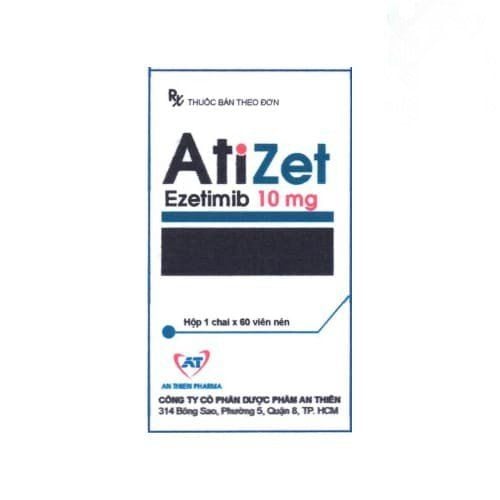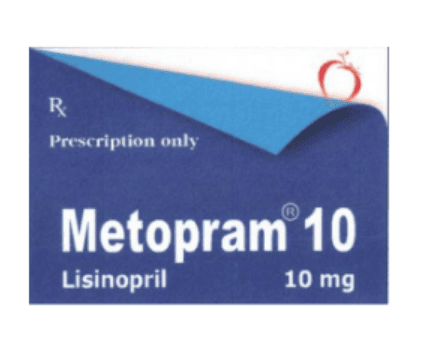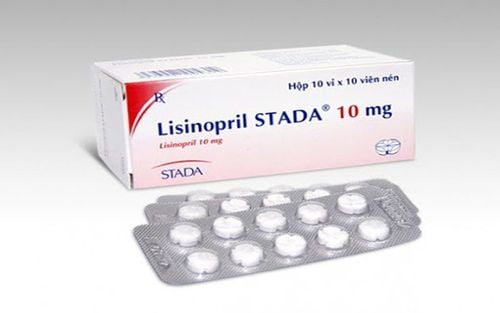This is an automatically translated article.
Maxxcardio-L 20 Plus is indicated for the treatment of hypertension, heart failure, diabetic kidney disease,... So how to use Maxxcardio-L 20 Plus? What precautions should be taken when using this drug? Let's find out the necessary information about the drug Maxxcardio-L 20 Plus through the article below.
1. What is Maxxcardio-L 20 Plus?
Pharmaceutical name: Maxxcardio-L 20 Plus
Drug group: Cardiovascular medicine
Manufacturing company: Ampharco U.S.A Pharmaceutical Joint Stock Company
Ingredients: Maxxcardio-L 20 Plus drug contains the main ingredient Lisinopril (below). Lisinopril dihydrate form) 20 mg; Hydrochlorothiazide 12.5 mg other active ingredients and excipients just enough strength to be supplied by the manufacturer.
Dosage form: Film-coated tablets
Packing: Box of 1 blister, 3 blisters, 10 blisters x 10 tablets (aluminum-aluminum press blister)
Content: Need to look carefully at the drug form and content stated on the product packaging or in the leaflet for exact information on the form of the drug and the content in the product.
2. Uses of Maxxcardio-L 20 Plus
2.1 Indications Treatment of hypertension: Used alone or in combination with other antihypertensive drugs such as thiazide diuretics, alpha blockers or calcium channel blockers... Treatment of heart failure: Use in combination with lisinopril with cardiac glycosides and diuretics for the treatment of congestive heart failure in patients receiving cardiac glycosides or diuretics alone without improvement. Hemodynamically stable acute myocardial infarction: Co-administration of lisinopril with thrombolytics, aspirin, and/or beta-blockers to improve survival in hemodynamically stable AMI patients determined. Lisinopril should be administered within 24 hours of a myocardial infarction. Treatment of diabetic kidney disease. 2.2 Dosage - How to use Lisinopril is a long-acting ACE inhibitor, so it is taken orally and once a day.
Adults:
Treatment of hypertension:
Initial dose: 5 - 10 mg/day, adjust dose according to the clinical response of the patient. Maintenance dose: 20-40mg/day. As a vasodilator, treatment of congestive heart failure:
Initial dose: 2.5 - 5 mg/day, adjust the dose according to the patient's clinical response. Maintenance dose: 10-20 mg/day. Myocardial infarction : Concomitant use with thrombolytics, low-dose aspirin and beta-blockers.
Initial dose: Administer 5 mg within 24 hours after symptoms of myocardial infarction occur, followed by 24 and 48 hours after dosing of 5 and 10 mg, respectively. Maintenance dose 10mg/day, continuous treatment for 6 weeks; If there is myocardial failure, the course of treatment lasts more than 6 weeks. Children : The effectiveness and safety of the drug has not been established.
Treatment of hypertension with renal failure:
If creatinine clearance is 10-30 ml/min, use an initial dose of 2.5 - 5 mg/time/day. If creatinine clearance is < 10 ml/min, use an initial dose of 2.5 mg once daily. Then adjust the dose based on tolerability and blood pressure response of each patient, but not more than 40 mg / time / day. Treatment of heart failure, with hyponatremia:
Serum sodium concentration < 130 mEq/liter, or creatinine clearance < 30 ml/min or serum creatinine > 3 mg/decilit, the initial dose must be reduced to 2, 5 mg. After the first dose, the patient should be monitored for 6-8 hours until blood pressure stabilizes.
Treatment of myocardial infarction and renal failure: (serum creatinine > 2 mg/decilit), lisinopril should be initiated cautiously (the dose adjustment in patients with myocardial infarction and severe renal impairment has not been quantified yet). price).
If renal failure (serum creatinine concentration > 3 mg/decilit) or if serum creatinine concentration increases 100% of normal during treatment, lisinopril must be discontinued. If the regimen requires a combination of diuretics in patients with severe renal impairment, loop diuretics such as furosemide should be preferred over thiazide diuretics. 2.3 Overdose and treatment Manifestations of overdose: possible drop in blood pressure.
Treatment: is an intravenous infusion of isotonic saline solution. Lisinopril can be removed by hemodialysis.
3. Contraindications
Contraindicated for patients:
Hypersensitivity to lisinopril, hydrochlorothiazide or any component of the drug. Hypersensitivity to other angiotensin converting enzyme inhibitors. Hypersensitivity to sulphonamide derivatives. History of angioedema during previous treatment with an angiotensin-converting enzyme inhibitor. Angioedema is hereditary or idiopathic. Pregnant women in the second and third trimesters of pregnancy. Severe renal impairment (creatinine clearance < 30 ml/min). Anuria. Severe liver failure. The use of Maxxcardio-L 20 Plus with products containing aliskiren is contraindicated in patients with diabetes mellitus or renal impairment (glomerular filtration rate < 60 ml/min/1.73 m?).
4. Drug interactions
When using two or more drugs at the same time, it is easy to have drug interactions leading to antagonism or synergism.
Drug interaction Maxxcardio-L 20 Plus with other drugs
Tubocurarine. Diuretics, potassium supplements, potassium substitutes, potassium-sparing drugs: lithium. Local anesthetics, anesthetics, hypnotics, other antihypertensive agents: indometacine. Oral antidiabetic drugs: insulin. Drug interactions Maxxcardio-L 20 Plus with food, drink
When using the drug with foods or alcohol, beer, tobacco... because in those foods and drinks contain other active ingredients Therefore, it can affect the phenomenon of antagonism or synergism with the drug. Read the instructions for use carefully or consult your doctor or pharmacist about taking Maxxcardio-L 20 Plus with food, alcohol and tobacco.
5. Side effects of the drug Maxxcardio-L 20 Plus
Common, ADR ≥ 1/100
Neurological: headache, dizziness, syncope. Cardiovascular: effects due to standing posture effects. Respiratory: cough. Gastrointestinal: diarrhea, vomiting Kidney and urinary: renal dysfunction. Uncommon, 1/1,000 < ADR < 1/100
Neurological: paresthesias, dizziness, dizziness, taste disturbances, sleep disturbances, mood swings, depressive symptoms. Cardiovascular: myocardial infarction or cerebrovascular accident, possibly secondary to excessive hypotension in high-risk patients, palpitations, tachycardia, Raynaud's syndrome. Respiratory: rhinitis. Gastrointestinal: vomiting, abdominal pain, dyspepsia. Hepatobiliary: increased liver enzymes and bilirubin. Skin: rash, itching. Rarely, 1/10,000 < ADR < 1/1,000
Neurological: confusion, olfactory disturbances. Blood: decreased hemoglobin, decreased red blood cell volume (HCT). Digestion: dry mouth. Skin: hypersensitivity/neuroedema. Kidney & urinary: uremia, acute renal failure. Very rare, ADR < 1/10,000
Blood: anemia, thrombocytopenia, pancytopenia, neutropenia, agranulocytosis. Metabolic: hypoglycemia, hyperglycemia. Respiratory: bronchospasm, sinusitis, allergic alveolitis/eosinophilic pneumonia.
6. Warnings and cautions when taking drugs
People with pre-existing kidney disease or taking high doses need to be monitored for proteinuria. Regular testing of white blood cells is necessary for people with collagen vascular disease or those taking immunosuppressive drugs.
People with heart failure or who are more likely to lose salt and water (eg, with diuretics or with dialysis) may experience symptomatic hypotension during the early stages of enzyme inhibitor therapy. transfer. This symptom can be minimized by giving a low starting dose, and should be given at bedtime.
Because serum potassium levels may increase during ACE inhibitor therapy, caution should be exercised when potassium-sparing diuretics are used, or when potassium is added.
Pregnancy: ACE inhibitors have a high risk of causing morbidity and mortality to the fetus and newborn if during pregnancy, especially in the second and third trimesters of pregnancy, she I take this medicine. Therefore, do not use lisinopril for pregnant women, if you are using the drug and find out that you are pregnant, you must stop taking it immediately.
Lactation period: It has not been determined whether the drug is excreted in breast milk or not, should not be used by people who are breastfeeding.
The effect of the drug on the ability to drive and use machines
The drug has not been shown to affect the driver and use machines, however, caution should be exercised because during the time of taking the drug may present a headache , tired.
Please dial HOTLINE for more information or register for an appointment HERE. Download MyVinmec app to make appointments faster and to manage your bookings easily.













